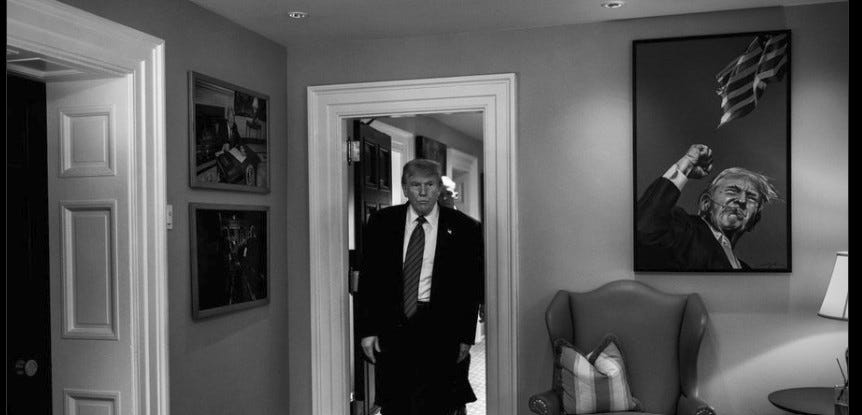
Donald Trump has steered the American economy into a perfect storm. In the book, film, and now in real life, a rare combination of destructive forces comes together and magnifies the damage. This storm could break the U.S. economy.
Trump’s tariffs are the most destructive force. Their first-order damages begin by arbitrarily driving up the prices of every product and input we import, followed by price hikes on most competing products and inputs made here. This will leave less money for everything else, depressing growth and jobs even as inflation accelerates—a textbook definition of stagflation. And these first-order costs are compounded by retaliatory tariffs by the primary targets of Trump’s levies, further slowing jobs, wages, and growth.
Six months ago, our economy grew at a healthy 2.8 percent rate, and inflation had eased sharply. Now, Trump’s policies have ushered in rising prices and the first stage of a recession.
His program’s second-order costs follow from the unprecedentedly high tariffs on goods and inputs from our three largest trading partners. The 145 percent tariffs on all Chinese imports and China’s 125 percent retaliatory tariffs have established for now a mutual embargo between the world’s two most important economies, alongside Trump’s 25 percent tariffs on most goods and inputs our companies buy from suppliers in Mexico and Canada.
If these policies remain in place, they will not only raise prices and slow the economy. By mid-summer, their punishing blows will disrupt supply chains, and Americans should expect the types of shortages their grandparents had to endure during World War II. Despite these inescapable second-order costs, Trump and his apprentice dealmakers have yet to begin negotiations with China, Mexico, or Canada—in large part because the president’s personal pique and economic delusions dictate our indefensible positions.
It gets worse. Most U.S. imports from our major trading partners are inputs for U.S. manufacturers, products made by their foreign subsidiaries, or energy we need, and truncating our access to those imports will damage a broad array of separate economic activities related to them. (Hat tip to Brad DeLong.)
Cripple our access to electronic parts from China, vehicles from Canada, or vegetables and fruits from Mexico, and American companies will have no choice but to wind down the jobs and spending for their related marketing, accounting and legal services, transport, and ultimate sales. Our economy will also lose the value American consumers and businesses derive from using those electronics, cars, trucks, and foodstuffs. It will pummel American manufacturers whom Trump claims he wants to help.
If Trump’s inane tariff regime remains in place for six months or longer, its first and second-order effects could trigger a deep recession akin to 1981-1982 and 2008-2009. And unlike those recessions, the Federal Reserve won’t be able to help much. The tariff-driven inflation will limit the central bank’s ability to cut interest rates, a dilemma that drove Trump to threaten Federal Reserve Chair Jerome Powell.
Equally important, the bond and equity markets’ thumbs-down responses to Trump’s tariffs and threats signal an even more serious problem: Investors are losing confidence in Trump, his presidency, and perhaps the United States. It’s especially true for foreign investors who reinforced the message by moving away from the dollar, because they’re investing less in our stocks and bonds.
If their response to our president’s ineptitude and capriciousness persists, it could be ruinous. The stability of our financial system depends on trillions of dollars in foreign capital. In 2024, foreign investors and governments held $18.4 trillion in U.S. stocks and $8.5 trillion in U.S. Treasury securities, about 30 percent of all our stock and 30 percent of all our bonds. While most American investors will likely wait out the coming storm, foreign investors with $27 trillion in American financial assets have plenty of alternatives. In a word, the United States could face destabilizing capital flight.
To stave off this grim prospect, the Treasury Department and American corporations will have to offer foreign and domestic investors higher returns. (Yields on U.S. treasuries soared after Trump revealed his chaotic tariff regime and have decreased only slightly since then.) So, regardless of what the Fed does, market interest rates may rise even as the economy declines.
It may not be very far off because the Treasury’s challenge to attract funds to keep the government running is coming to a head. The Treasury already planned to float $1.8 trillion in new bonds in 2025, and that burden will increase substantially as the economy weakens. On top of that, Republicans in Congress will very soon approve Trump’s deficit-busting budget, draining $5 trillion in revenues over 10 years for another round of his 2017 tax cuts, which are set to expire and perhaps up to $4 trillion more for Trump’s other tax promises, plus another $1.5 trillion in increased defense spending.
Trump and his economic courtiers count on tax cuts and higher spending to ward off recession, and in normal times, they might have been right. But their hopes are delusions under the new conditions they’ve created since the higher interest rates needed to attract the capital the government and U.S. corporations need will thwart most or all of any stimulus.
Our gathering economic storm includes another feature that could drive the economy onto the rocks. Apart from the tariffs, Trump’s aggrieved attacks on the rule of law also threaten the willingness of foreign investors to continue holding and buying American bonds and stocks. Along with the rest of us, they see Trump and his administration unilaterally abrogating contracts, withholding appropriated funds, dismissing court decisions, attacking judges for enforcing their rulings, deporting people without charges or hearings, providing special treatment for large contributors and favored companies, and threatening law firms and universities without any legal basis.
The erosion of the rule of law under Trump can have enormous economic significance for a foreign government, investor, or company with stakes in our economy. They now know that the U.S. government may ignore its contracts with them or decide not to enforce their agreements with others when it serves the political or personal interests of the president. That’s the way the world works in the kleptocratic dictatorships in Russia and Venezuela, and virtually no one invests in their stocks and bonds.
By following their lead, Trump and his apprentices risk devastating capital flight that could leave many of our leading financial institutions insolvent. In addition to his deeply destructive tariffs, Trump’s sweeping campaign against the rule of law in the United States has raised the economic stakes from a rocky business cycle to a potential financial and economic meltdown with terrible consequences.
The post Trump’s Perfect Storm that Could Sink the American Economy appeared first on Washington Monthly.


 1 month ago
12
1 month ago
12 










 Bengali (Bangladesh) ·
Bengali (Bangladesh) ·  English (United States) ·
English (United States) ·